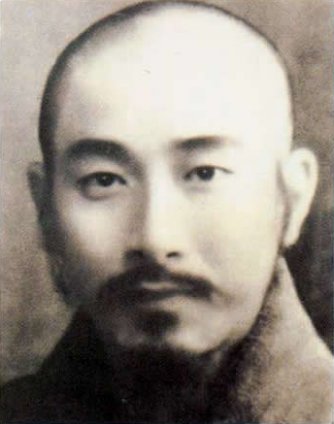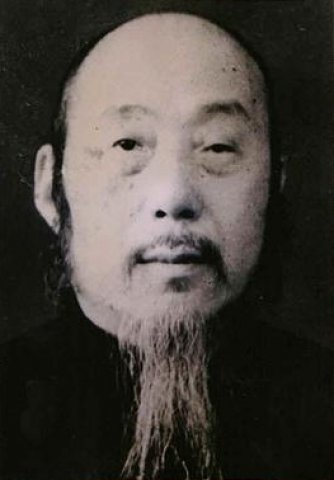| Library / Biographies |
Nan Huai-Chin Biography

Nan Huaijin in 1945, after descending Mount Emei following his time as a hermit.Nan Huai-Chin was born March 18, 1918, to a scholar class family in Yueqing county, Wenzhou city, Zhejiang province.
In his youth, Nan received a classical education that included various Confucian and Taoist works, as well as traditional Chinese medicine, literature, calligraphy, poetry, and other subjects.
At the age of 18, he became the provincial martial arts champion after studying several Chinese martial arts including swordsmanship with the jian.1
Nan studied social welfare at Jinling University and later went on to teach at the Republic of China Military Academy in Nanjing.
In the late 1930s at the age of 21 years, Nan became a military commander at the border regions of Sichuan, Xikang, and Yunnan during the Second Sino-Japanese War. There, he led a local group of 30,000 men against the Japanese invasion.
In 1942 Nan left his military career so that he could commit himself fully to his study of Buddhism and to meditation. He went on a three-year meditation retreat in the Emei Mountains. It is said that it was there that he verified his experiences against the Chinese Buddhist canon. During this time, Nan's primary teacher was Yuan Huanxian (1887 – 1966).
In 1945, Nan went to seek out the teachings of Tibetan Buddhism. The 9th Gangkar Rinpoche (1893 – 1957), a high-ranking tulku of the Kagyu school, also verified Nan's experiences, giving him the title "Vajra Master."2 Nan was one of the few multidisciplinary experts in the world to be versed in the cultivation schools of Confucianism, Taoism, Tibetan Buddhism, and Chan Buddhism. His Dharma name3 was Tōngchán.

Yuan Huanxian, one of Nan Huai-Chin's teachersFollowing the revolution in China, Nan moved to Taiwan in 1949 where he became a well-known university professor and author, teaching at National Chengchi University, Chinese Culture University, and Fu Jen Catholic University.
His first book, The Sea of Chan, was published in 1955, and was the first in a line of over 40 books and related materials published in his name.
Nan's books have achieved a great deal of popularity in mainland China and Taiwan. In total, more than 20 million copies of his books have been sold in Chinese-speaking countries.
Some of his more popular works have gone to a 20th printing in Taiwan and his works on Confucianism are used as standard university references in the mainland and Taiwan.
In the late 1980s and early 1990s, Nan mediated secret cross-strait communications between the mainland China and Taiwan. Two of Nan's students were close confidants of Taiwan's President Lee Teng-hui, and Nan was approached by his student Jia Yibin about creating a communication channel between Lee Teng-hui and mainland China's President Yang Shangkun.
Both Jia and Nan mediated negotiations, and successfully realized secret chamber meetings between special envoys. In the early 1990s, Nan changed his place of residence from Taiwan to Hong Kong.
In January 1992, Nan signed a contract with the Chinese government and invested 92 million RMB in the Jinhua–Wenzhou Railway, which is the first joint-stock railway in China. In 2004, Nan returned to the mainland near Suzhou.
in 2006, Nan founded the 200-acre (0.81 km2) Taihu Great Learning Center, in Wujiang District, Suzhou, China which contains the Wujiang Taihu International School.
The school curriculum is meant to combine the best approaches of traditional China and the West. It has unique emphases such as meditation, ethics and etiquette, traditional Chinese medical theory, and Chinese and English recitation.
The name of the school is in reference to the Great Learning, one of the "Four Books" of Confucianism.
Nan died at the age of 94 on September 29, 2012, in Suzhou, Jiangsu, China
Books in English
This is a list of translations of Nan Huai-Chin's books. The vast majority of books written by Nan have not been translated into the English language from the original Chinese.
• 1984 Tao & Longevity: Mind-Body Transformation
• 1986 Grass Mountain: A Seven Day Intensive in Ch'an Training With Master Nan Huai-Chin
• 1993 Working Toward Enlightenment: The Cultivation of Practice
• 1994 To Realize Enlightenment: Practice of the Cultivation Path
• 1995 The Story of Chinese Zen, Paperback
• 1997 Basic Buddhism: Exploring Buddhism and Zen
• 2004 Diamond Sutra Explained
Sources
• https://en.wikipedia.org/wiki/Nan_Huai-Chin
• Grass Mountain - A Seven Day Intensive in Ch'an Training With Master Nan Huai-Chin
Footnotes
1. The jian is a double-edged straight sword used during the last 2,500 years in China.
2. A Vajra Master is a qualified Vajrayana master, the spiritual authority who is empowered to transmit the Vajrayana teachings and its related practices and to lead such practices in a group assembly.
3. A Dharma name is a new name acquired during a Buddhist initiation ritual in Mahayana Buddhism and monk ordination in Theravada Buddhism. The name is traditionally given by a Buddhist monastic, and is given to newly ordained monks, nuns and laity. Dharma names are considered aspirational, not descriptive.





